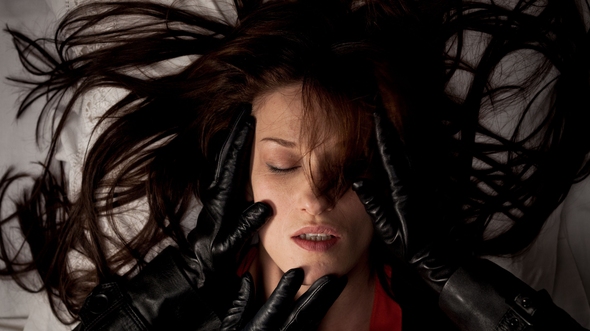Koo! Kin-dza-dza (dir. Georgiy Daneliya & Tatiana Ilyna)
Image courtesy of EIFF
Present day Moscow. World famous cellist and cultural snob Vladimir Chizov and wannabe hipster DJ Tolik are accidentally catapulted onto a strange and desolate planet known as Puke. How will they make it back to Earth? This is the premise of Koo! Kin-dza-dza, an animated remake of the homonymous 1986 Soviet sci-fi satire.
It's refreshing too see an animation that doesn't have to rely on CGI or 3D, especially when it skillfully infuses a picaresque story line with the absurdist touches of Terry Gilliam's Brazil. In the dune world of Pluke, inhabitants fall into two main categories - Patsaks and Chatlanians (the latter being the dominant people), a humble match (known as a ketse) is the most valuable item, and common sense doesn't seem to apply as strict hierarchies extend to the colour of pants one wears. The two main characters must fight their way through unreliable journey companions, perennial bribes and cacophony-loving grandmothers. The comic darkness of this dystopian universe is occasionally provided with light relief: it's hard not too smile when Vladimir plays his cello for an unusually appreciative and rather timid Plukian creature, or when Vladimir and Tolik seem to finally make an emotional connection.
For all its analogue ambition, Koo! Kin-dza-dza is far from perfect - clocking in at 96 minutes, it feels overlong, leaving us with the impression that the script could have been much tighter in parts.
Seeing this film presented again in the 21st century, when the USSR has become a distant memory makes for thought-provoking viewing, as its powerful depiction of laughable hierarchical structures, corruption and racism still resonates in contemporary Europe.
Koo! Kin-dza-dza , 27 June, 18:15 at Odeon 2
[Erika Sella]
Anatomy of a Paperclip (dir. Akira Ikeda)
Director Ikeda Akira has stated that his starting point for Anatomy of a Paperclip was his wish to create the modern equivalent of a Japanese folk tale.
The quiet, submissive Kogure is certainly the kind of character that can be found time and time again in both literature and film (his body language and tubby, inexpressive appearance reminded me Italian popular cinema staple Fantozzi); the linear simplicity and even pacing of the storyline (matched by the minimalist, deliberately two-dimensional and immaculately balanced, often symmetrical shots) are also somewhat reminiscent of a parable.
Image courtesy of EIFF
The flat cinematography also complements the deadpan humour that springs from a world that has become devoid of pleasure - this is Japan, but not as we know it. Kugore lives in a small, bare room, works in a factory (which actually looks like a converted garage) where he is repeatedly abused by his horrific boss, survives on horrible food and is regularly taunted by a couple of thugs who have a penchant for stealing his clothes. This routine is gradually eroded by the vision of a butterfly (a presence usually loaded with meaning in Japanese culture) and the consequent appearance of a woman who speaks gibberish (a 'language' that was invented by the filmmaker) and decides to move into Kogure's bedsit without an explanation.
At the press screening, a fellow viewer felt that Anatomy of a Paperclip was 'essentially a Japanese remake of Eraserhead'; while the bleak, quietly hysterical atmosphere that pervades the film may certainly recall some aspects of David Lynch's output, I felt this statement detracts from the film's complexity. This is a mysterious and often profound film; a poignant (yet very funny) comment about human nature and the meaning of interpersonal connections.
Anatomy of a Paperclip, 28 June, 13:15 at Cameo 3
[Erika Sella]
Displaced Perssons (dir. Asa Blanck and Johan Palmgren)
Image courtesy of EIFF
Pelle Persson is one of the most intriguing characters I have ever had the privilege to encounter on the big screen; perhaps inspired by a childhood adventure book (having recently watched Mark Cousin's A Story of Children and Film, I was reminded of Palle Alone in the World, and not simply because of the similarity of the main character's name), he sets off to adventure as soon as he is old enough to drive, living and working in Europe, Africa and the Middle East. He eventually settles in Lahore, Pakistan, where he marries Shamin, and has two daughters. As his children reach adulthood, he finds that his liberal parenting idea clash with the local customs (the girls find they can't leave the house by themselves), and decides to return to his native Sweden. But can you ever go home again?
This is a documentary that tackles complex issues such as identity, the meaning of national cultures and of family ties. It's hard not to like the Perssons as they face their Swedish adventure with defiance and a great deal of humour, but also with fear and maybe some regret; the camera only needs to sit back and watch them, letting the occasional title card guide us through the passing of time. We see the deadpan Shamin braving the freezing winter and unenthusiastically learning Swedish, Pelle having to prove to the local bureaucrats that he still exists in order to receive his pension, their daughter Zahra struggling with life-changing decisions. There is no place for stereotype here - both Sweden and Pakistan are represented in ways that we not normally accustomed to. We are faced with a family that don't conform to the narratives we are fed by the popular press: Pelle, Sharmin, Zahra and Mia all prove that identity is something complex, fluid and not necessarily defined by a country of birth, and that love and family really can overcome the biggest difficulties. As soppy as that might sound, there was not a dry eye at the screening - Displaced Perssons delivers the kind emotional punch that is becoming increasingly rare. Do not miss.
Displaced Perssons, 27 June, 18:10 at Cameo 3
[Erika Sella]
Snowpiercer (dir. Joon-ho Bong)
It’s quite startling that an actor better known as Captain America (AKA Chris Evans…no, not that one) to many should be the protagonist of a film that critiques Capitalism quite so overtly (if in an occasionally naïve, often daft way). The premise is a bit silly but clearly analogous: in a post-apocalyptic world, a train rattles around the world carrying three groups of people, the last humans left on Earth – an elite that lives at the luxurious front, a servile group that do their bidding, and lumpenproletariat that dwell in slum-like carriages at the rear. Evans’ Curtis leads a revolt, blood is shed and a fable of the perils of Capital emerges through action setpieces and a great deal of humour. It does feel a little lacking in nuance in its politics and is silly in that comic-book-film way at times, but is enjoyable all the same. John Hurt expertly plays the wise old man, Tilda Swinton is a hilariously grotesque Lancastrian spokesperson, Kang-ho Song amuses as the drug-addled security expert and Jamie Bell is an entertaining sidekick (if a little heavy on the Oirish Eejit schtick) to Evans’ hirsute and oh-so-tortured American hero.
Image courtesy of EIFF
Snowpiercer may struggle to escape the inherent limitations of its form but is entertaining with both heart and head in the right place. One can’t help but feel that Harvey Weinstein has probably bludgeoned Joon-ho Bong’s film into something more straightforward for Anglophone audiences than it may have been in the form shown to audiences in South Korea and elsewhere, but entertains and manages to be not entirely brainless with it, which is more than can be said yer average comic book (sorry, graphic novel) adaptation.
Snowpiercer, 28 June, 20:15 at Cineworld 3
[Andrew R. Hill]
The Cheviot, The Stag, and the Black Black Oil (dir. John McGrath)
Buried treasure screened on Saturday afternoon as a part of Dick Fiddy of the BFI’s lovingly programmed Border Warfare: John McGrath’s Work in TV, Theatre, & Film thread at the EIFF 2014. John McGrath’s The Cheviot, The Stag, and the Black Black Oil shouldn’t work; a Brechtian play filmed live (audience and all) with inserted dramatised exterior scenes (with different actors from those in the play), contemporary interviews with real people, Gaelic folk songs, Scottish country dancing and old-fashioned one-liner comedy collide in an hour and a half that is by turns tragic, didactic, polemical and hilarious.
The play takes three instances of the Scottish Highlands being carved up by outside forces, from the Clearances through to the Victorian stag hunting playground to North Sea oil. An unashamed attack on Capitalism, The Cheviot… is a breath-taking work of deceptive complexity – detailed, rich, informative, entertaining and moving. That it was screened on BBC One is astonishing now, especially on a weekend where the BBC News has proven itself to be little more than the propaganda wing of the Tory government, failing to report 50,000 people marching from its own headquarters to protest anti-austerity measures. That the film has yet to be released on DVD is, sadly, not much of a surprise – and, no, a screening on BBC Alba in 2012 isn’t enough (and Auntie’s tack has shifted all too far in the wrong direction in the interim). Luckily, YouTube saves the day – it really is essential viewing.
The EIFF should be commended for unshowily yet unashamedly political programming, in an era where artists (by which I include filmmakers, musicians and writers) seem content to shy away from politics altogether, for fear of alienating audiences – audiences that are often very receptive. John McGrath certainly was no such artist and the opportunity to discover (or, indeed, rediscover) his work is an unmissable opportunity.
[Andrew R. Hill]





































